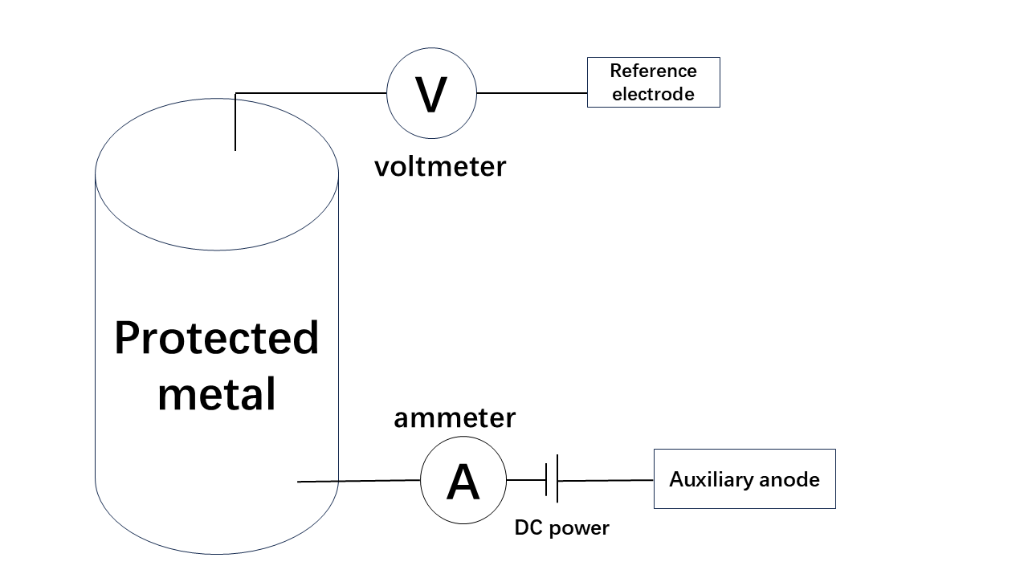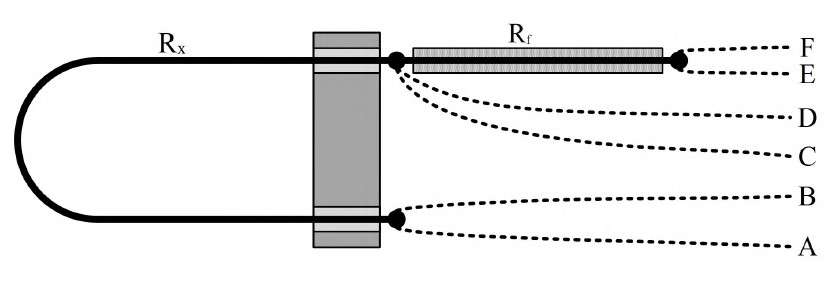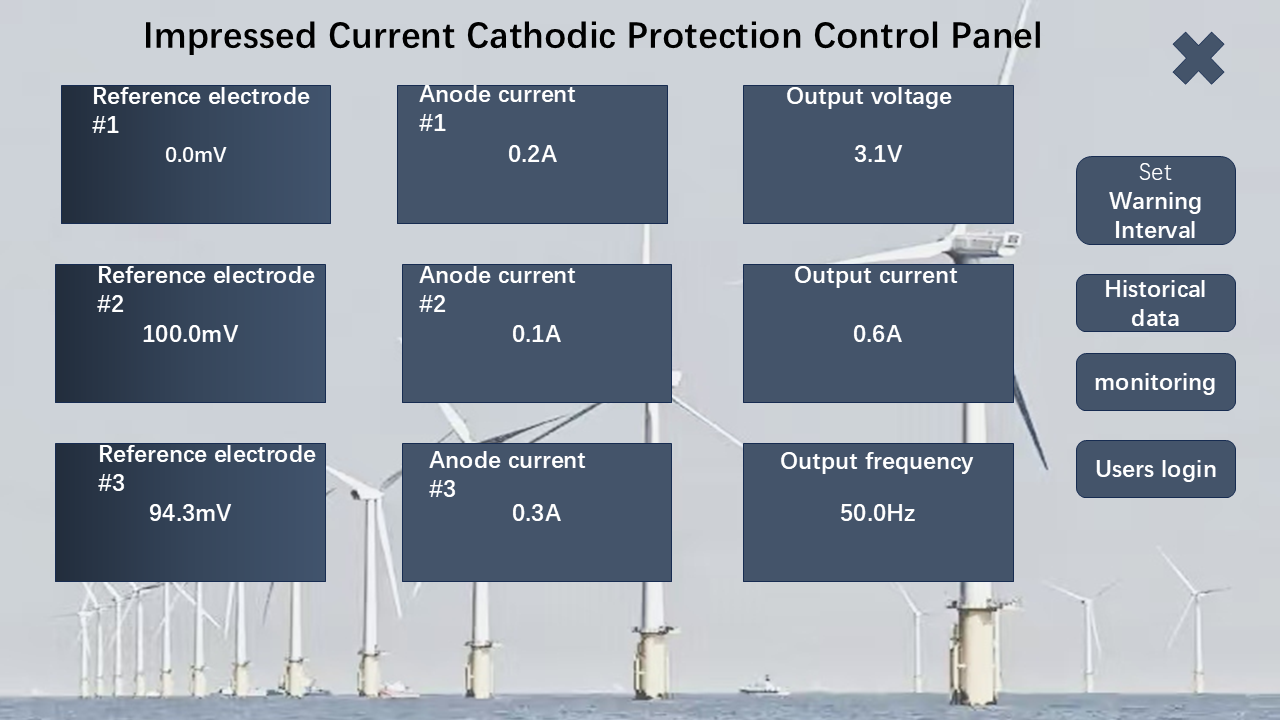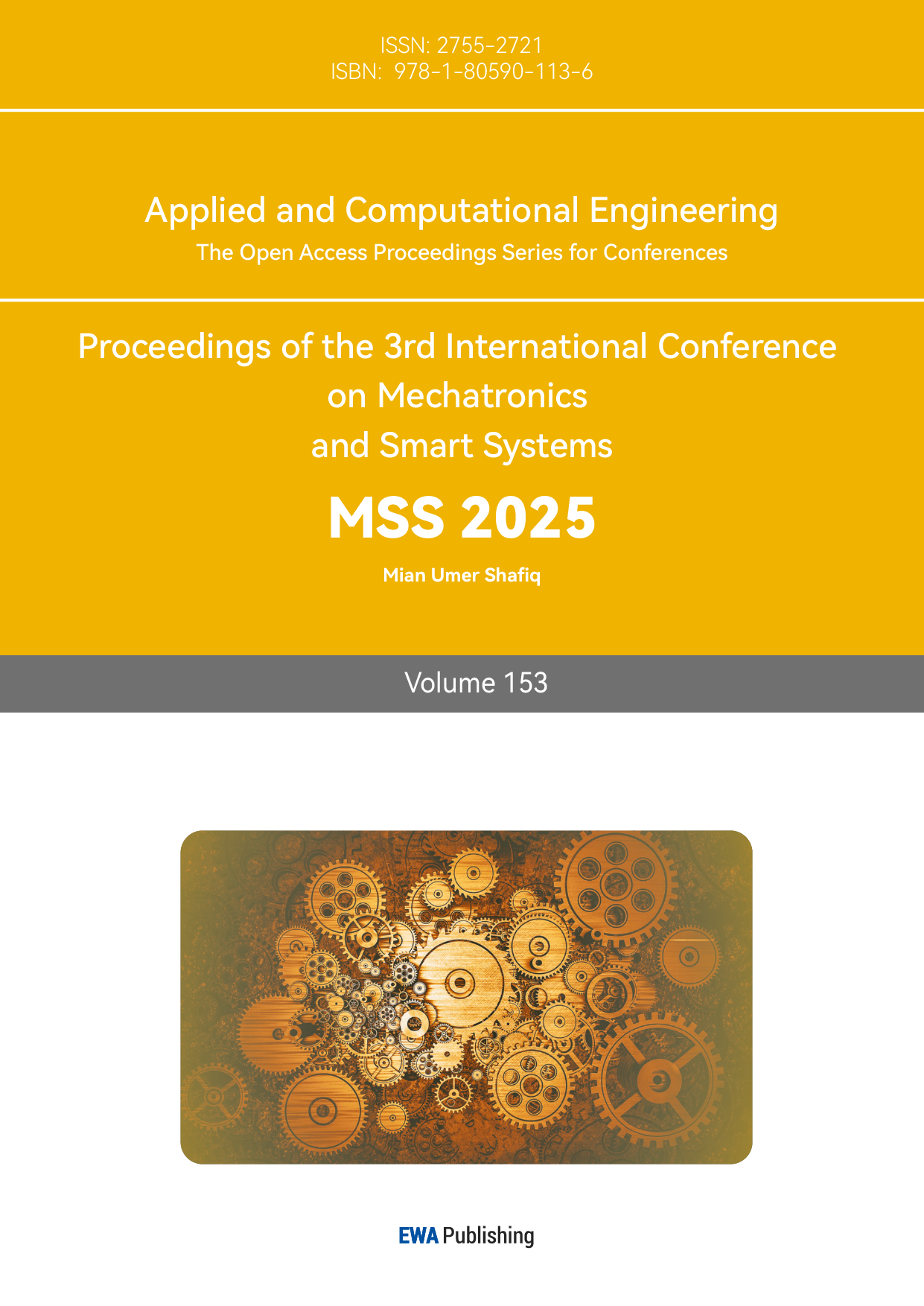1. Introduction
As the world shifts towards clean energy to meet “carbon peak” and “carbon neutrality” goals, offshore wind power has become a crucial component due to its vast potential. However, the harsh marine environment, with high salinity, humidity, and fluctuating temperatures, presents significant corrosion challenges that affect the structural integrity and operational efficiency of offshore wind turbines. Effective and economical corrosion protection is thus a critical research topic.
Despite existing corrosion protection technologies such as coatings and cathodic protection, there are still limitations, including high maintenance costs and insufficient durability. Moreover, traditional methods lack real-time monitoring capabilities and adaptability to dynamic marine conditions. The unique corrosion risks in different zones, such as the splash and tidal zones, further complicate protection strategies. While intelligent and digital technologies offer promising solutions, their integration into corrosion protection is still in the early stages.
This review aims to systematically analyze the zonal characteristics and mechanisms of marine corrosion, summarize the limitations of existing protection technologies, and explore the innovative applications of intelligent and digital technologies in corrosion monitoring and protection. It also seeks to propose future directions for technological advancements to enhance the safe and efficient operation of offshore wind turbines.
2. Marine Corrosion Environment Zoning and Corrosion Mechanisms
The infrastructure of offshore wind turbines, especially the Monopile (MP) and Transition Piece (TP) connections, are exposed to complex Marine environments for a long time and face serious corrosion challenges. It is shown that the interaction of pitting corrosion and fatigue corrosion poses a significant threat to the integrity of the structure[1]. This coupling effect not only leads to the occurrence of local defects, but also changes the failure mode of the structure from global bending to local buckling[2]. Therefore, a deep understanding of corrosion mechanisms is essential to evaluate and optimize corrosion protection strategies for offshore wind turbines.
The marine environment is one of the most corrosive natural environments[3].As is mentioned in Table 1, the marine environment can be divided into the marine atmospheric zone, splash zone, tidal zone, full immersion zone, and subsea mud zone from a corrosion research perspective. The corrosiveness of each zone can be classified according to standards such as ISO 9223[4].
The marine atmospheric zone is affected by sea salt particles and terrestrial atmosphere, with high humidity and strong ultraviolet radiation. Localized pitting, galvanic corrosion, and crevice corrosion caused by high salinity and humidity can lead to issues such as blade aging and cracking. Research shows that the corrosion of wind turbine steel structures under atmospheric conditions mainly occurs in a thin water film on the metal surface. This film contains dissolved gases (e.g., oxygen, hydrogen sulfide), salts, and pollutants, leading to electrochemical reactions with the steel. Typical reactions include oxygen absorption corrosion and hydrogen evolution corrosion.
The splash zone faces challenges such as salt accumulation, wet-dry cycles, and biofouling, with particularly noticeable corrosion aging and fatigue damage. The tidal zone, due to tidal action, has abundant surface oxygen, making it a cathode for oxygen concentration cells and thus mitigating corrosion. The full immersion zone primarily experiences electrochemical corrosion, along with seawater scour and microbial corrosion. The subsea mud zone generally experiences mild corrosion but may be affected by anaerobic microbial metabolic activities[4].
Table 1: Environmental Zoning and Classification of Environmental Corrosion.
Environmental Zoning | Classification of Environmental Corrosion |
Internal Atmospheric Zone | C4 |
External Atmospheric Zone | C5/CX |
Splash Zone, Tidal Zone | IM2/CX |
Full Immersion Zone | IM2/IM4 |
Subsea Mud Zone | IM3/IM4 |
3. Existing Corrosion Protection Solutions
The main corrosion protection technologies applied in offshore wind turbines include protective coatings, corrosion-resistant materials, and cathodic protection methods.
3.1. Anti-Corrosion Coatings
Anti-corrosion coatings are the most widely used corrosion protection technology in marine environments[4], effectively isolating seawater, salt spray, oxygen, and other corrosive substances. For structures exposed to the marine atmosphere, such as towers and blades, coatings can also block ultraviolet radiation, delaying equipment aging.
Common heavy-duty anti-corrosion coatings include epoxy, polyurethane, and zinc-rich coatings[5]. Among these, epoxy heavy-duty anti-corrosion coatings provide long-term protection through physical shielding, corrosion inhibition, and electrochemical protection[6].
Physical shielding is one of the key functions of epoxy coatings, primarily by blocking direct contact between the metal substrate and external corrosive media (e.g., water molecules, oxygen, chloride ions), thereby slowing the corrosion process. To enhance coating performance, researchers have introduced two-dimensional layered micro/nano inorganic fillers into epoxy resins, significantly improving adhesion, flexibility, and durability while extending the penetration path of corrosive media[4].For example, Yang Maonan et al.[7] successfully prepared graphene-epoxy resin composites with excellent anti-corrosion properties using a one-step method, achieving over 2000 hours of salt spray resistance.
Additionally, adding corrosion inhibitors to epoxy coatings is an effective protection strategy[6] . Corrosion inhibitors slowly release from the coating and react with the metal surface to form a passivation film, inhibiting the anodic oxidation reaction and enhancing corrosion resistance. This corrosion inhibition effect complements the physical shielding of the coating, further improving overall protection.
Another common anti-corrosion method is adding pigments with a more negative potential than steel (e.g., zinc or aluminum powder) to the epoxy coating. By maintaining conductive pathways between the pigments, the protected metal becomes the cathode, while the more negative pigments act as anodes and corrode preferentially, providing electrochemical protection[6].
Through the combination of these technologies, the protective performance of epoxy coatings has been significantly enhanced, offering reliable long-term corrosion protection for offshore wind turbines and other marine engineering facilities.
In recent years, Microbiologically Induced Calcite Precipitation (MICP) technique, as a new corrosion protection method, has attracted extensive attention. The research shows that MICP technology can form a biological reinforcement layer around the pile foundation through the action of microorganisms, and significantly enhance the bearing capacity and stiffness of the pile foundation. This technology can not only effectively improve the corrosion resistance of pile foundation, but also repair the damaged surface through biomineralization[8]. However, edge scour may reduce the embedment depth of the bioreinforcement layer, thus reducing its reinforcement effect. Therefore, when applying MICP technology, it is necessary to consider the scour effect in the Marine environment comprehensively, and design corresponding protective measures to ensure the integrity of the reinforced layer[8].
3.2. Anti-Fouling Coatings
There are approximately 2,000 to 3,000 species of fouling organisms in the ocean, including sessile organisms, adhesive microorganisms, and attached plants[5] .As shown in Figure 1,Marine biofouling typically occurs in three stages: conditioning film formation, biofilm development, and fouling community establishment[9] . When a surface is immersed in seawater, organic substances such as polysaccharides, proteins, and glycoproteins quickly deposit on the surface through van der Waals forces, hydrogen bonds, and electrostatic interactions, forming a conditioning film. Within a day, bacteria and diatoms attach to this film, secreting extracellular polymeric substances (EPS) to enhance adhesion, forming a biofilm composed of water, organic matter, microorganisms, and their metabolites. This biofilm provides a rich food source for algae spores and protozoa, leading to the formation of a mucus layer within days. Over weeks, larger fouling organisms such as barnacles, mussels, and macroalgae attach and grow, forming complex communities. After months, large-scale fouling occurs, causing significant biofouling issues.

Figure 1: Three stages of marine biofouling formation[9].
In the full immersion zone, structures inevitably face biofouling. Anti-fouling coatings aim to prevent marine organism attachment, maintaining smooth and clean surfaces. In the late 18th century, toxic substances like arsenic, sulfur, and mercury were used to prevent biofouling. Later, organotin compounds became widely used in marine anti-fouling. However, traditional anti-fouling coatings caused severe environmental pollution and were gradually restricted or banned.
Natural anti-fouling agents, micro/nano-structured anti-fouling materials, liquid-infused porous surfaces, and hydrogel anti-fouling coatings are environmentally friendly alternatives. However, these coatings often suffer from high development costs and poor stability, requiring further research. Chinese researchers have developed environmentally friendly self-polishing anti-fouling coatings using natural capsaicin, isothiazolinone anti-fouling agents, and capsaicin-functionalized resins, achieving 12 to 24 months of anti-fouling performance in the Yellow Sea, East China Sea, and South China Sea. Recent studies have shown that adding nanomaterials to coatings also improves anti-fouling performance[5].
3.3. Cathodic Protection
Cathodic (electrochemical) protection includes sacrificial anode cathodic protection and impressed current cathodic protection.
Sacrificial anode cathodic protection uses the galvanic effect, connecting a more negative and active metal as the sacrificial anode to the protected metal in the same electrolyte. The sacrificial anode corrodes preferentially, while electrons flow to the protected metal, making it the cathode and protecting it.
We can understand the mechanism of impressed current cathodic protection through Figure 2. It uses an external power source to polarize the protected metal structure as a cathode, inhibiting corrosion. This is achieved through:
1.External power source: The system requires a DC power source, with the negative terminal connected to the protected metal and the positive terminal connected to an auxiliary anode.
2.Auxiliary anode: Distributes the protection current evenly across the protected metal.
3.Reference electrode: Monitors the potential of the protected metal to ensure it remains within the desired protection range.
4.Protection potential: Controls the current to maintain the protected metal at a negative potential, typically -850mV (relative to a copper sulfate electrode).

Figure 2: Schematic of impressed current cathodic protection.
4. Intelligent and Digital Empowerment of Corrosion Protection
Although traditional corrosion protection technologies, such as anti-corrosion coatings and cathodic protection, have been widely used in offshore wind turbines, these technologies still face many challenges in complex Marine environments. Especially when the coupling effects of pitting corrosion and fatigue corrosion are considered, the traditional protection methods are often unable to accurately evaluate the local defects and residual properties of structures[10]. Therefore, the development of more intelligent and efficient corrosion monitoring and protection technology is particularly urgent.
With the development of smart ships and platforms, the offshore wind industry is gradually responding to initiatives like "Internet + Smart Wind Farms," raising new requirements for corrosion protection. Addressing the high costs and low efficiency of traditional corrosion protection methods, intelligent and digital reforms are being implemented. These reforms enable real-time monitoring and precise data collection, reducing maintenance costs and improving efficiency.
4.1. Digital Monitoring
Digital monitoring systems allow remote, real-time monitoring of corrosion conditions, significantly reducing labor costs and improving monitoring efficiency.
Ultrasonic thickness measurement technology can non-destructively measure material thickness by analyzing ultrasound propagation time, making it suitable for corrosion monitoring. Upeksha Chathurani Thibbotuwa et al.[11] developed a low-power, low-cost ultrasonic corrosion monitoring system for offshore wind turbines in the splash and atmospheric zones. The system uses fixed sensors in the splash zone and drones for mobile monitoring in the atmospheric zone. It accurately measures steel thickness between 40 mm and 70 mm and can operate unattended for long periods, transmitting data wirelessly to a central processing unit. Experimental results show the system achieves 1-micron precision in measuring coated and uncoated steel. Additionally, the system's signal processing algorithm improves time-of-flight (ToF) measurement accuracy using cross-correlation techniques, ensuring reliability and stability in complex environments.

Figure 3: Schematic of a resistance probe sensor[12].
Resistance probe sensors (TER) can also monitor metal corrosion by measuring the increase in resistance of a metal wire or film during corrosion. Figure 3 shows the schematic of a resistance probe sensor. The metal loss is calculated based on the linear relationship between cross-sectional area and resistance, making it particularly suitable for uniform corrosion monitoring. The sensor consists of a measurement resistor ( \( {R_{x}} \) ) and a reference resistor ( \( {R_{f}} \) ), with \( {R_{x}} \) exposed to the environment and \( {R_{f}} \) sealed. During operation, a constant current is applied to terminals A and F, and the voltages across \( {R_{x}} \) and \( {R_{f}} \) are measured to calculate the remaining radius and corrosion rate of the wire[12] \( {L_{x}} \) and \( {L_{f}} \) are the lengths of the measurement and reference wires, respectively; \( {r_{x}} \) and \( {r_{f}} \) are their radii. The remaining radius \( {r_{x}}(t) \) at time t and the corrosion rate are given by:
\( {r_{x}}(t)= \sqrt[]{\frac{C}{λ(t)}} \) ; \( C=\frac{{L_{x}}}{{L_{f}}} \) \( {r_{f}} \) 2;
\( V=\frac{rx(t2)-rx(t1)}{t2-t1} \) ;
The monitoring system consists of sensors, a monitoring platform, and a data transmission platform. Meng Xueyin et al.[13] developed a corrosion monitoring system for offshore wind turbines using resistance probe sensors, installed in a South China Sea wind farm. Data is transmitted via 4G to a cloud server for collection and display, accessible via web or mobile app. The study evaluated the corrosion environment and fitted a power function model for corrosion over time.
Other common electrochemical corrosion monitoring methods include polarization curve scanning, electrochemical impedance spectroscopy, and electrochemical noise analysis[14].
4.2. Intelligent Cathodic Protection
Although the theoretical framework is well-established, the actual operating environment of cathodic protection systems is complex and variable, with unstable current supply, making routine inspections difficult and posing safety risks.
Wang Shengjun et al.[15] experimentally studied the application of intelligent, big data, and IoT technologies in cathodic protection systems. The impressed current cathodic protection system consists of three core modules: a data-feedback potentiostat that automatically adjusts and maintains a constant control potential for the protected structure; an auxiliary anode; and a reference electrode for measuring the potential of seawater-immersed steel structures. The intelligent system adds potential detection units, communication boxes, uninterruptible power supplies (UPS), and integrates big data cloud platforms and remote online monitoring, achieving comprehensive system upgrades.
Remote monitoring alone is insufficient for efficient, unmanned cathodic protection. Remote control capabilities are also needed. He Jing et al.[16] proposed a corrosion protection solution for large-diameter monopile foundations in the Zhanjiang Wailuo offshore wind farm, combining coating protection with impressed current cathodic protection and designing a remote automatic monitoring system. The system's core idea is to install on-site control units on wind turbines to collect potential data from multiple reference electrodes in the foundation structure. Data is transmitted via wired or wireless means to a central control room for analysis. Central control room staff can send remote commands to the on-site units, enabling remote parameter settings and real-time monitoring. The system uses cathodic protection online detection software to analyze data and assess corrosion conditions. When the protection potential exceeds set limits, the system alerts users. Figure 4 shows an ideal picture of an intelligent control panel for an impressed current cathodic protection system.

Figure 4: Schematic of an intelligent control panel for an impressed current cathodic protection system.
5. Future Prospects
With the rapid development of the offshore wind industry, intelligent and digital corrosion protection technologies have become important research directions. This paper highlights the applications of intelligent and digital technologies in corrosion monitoring and protection, with significant potential for future development, particularly in optimizing and innovating intelligent corrosion monitoring systems. The following areas are worth exploring:
5.1. Precision and Multifunctionality of Intelligent Monitoring Systems
Current intelligent corrosion monitoring systems have been preliminarily applied in offshore wind turbines but still face issues such as insufficient precision and limited functionality. Future studies should further explore the combination of intelligent monitoring techniques and reliability analysis to optimize corrosion protection strategies for offshore wind turbines. For example, by modeling corrosion and fatigue coupling damage, combined with real-time data from intelligent monitoring systems, residual performance and service life of structures can be more accurately assessed[10]. In addition, the development of high-precision sensors and multi-parameter monitoring systems will help improve the accuracy and intelligence of corrosion monitoring, and provide a stronger guarantee for the safe operation of offshore wind turbines.
5.2. Real-Time and Reliable Data Transmission and Processing
As offshore wind farms expand, data transmission and processing become critical. Future research should focus on low-power wireless transmission, edge computing, and data security to ensure stable and efficient data handling.
5.3. Optimization of Intelligent Cathodic Protection Systems
Cathodic protection is a key method for offshore wind turbine corrosion protection, but its intelligence needs improvement. Future directions include remote control, multi-turbine cooperative protection, and energy efficiency optimization.
5.4. Deep Application of AI in Corrosion Protection
AI has broad prospects in corrosion monitoring and protection. Future applications could include corrosion prediction, intelligent diagnosis, and data-driven protection strategy optimization.
6. Conclusion
Corrosion protection is crucial for the long-term safe operation of offshore wind turbines. This paper systematically analyzes the zonal characteristics and mechanisms of marine corrosion, summarizes existing protection technologies, and highlights the innovative applications of intelligent and digital technologies in corrosion monitoring and protection. While existing technologies like anti-corrosion coatings, corrosion-resistant materials, and cathodic protection have been widely applied and proven effective, they still face limitations in complex marine environments.
With the rapid development of intelligent and digital technologies, corrosion monitoring and protection are entering a new era. Digital monitoring systems, intelligent cathodic protection, and AI applications offer more efficient and precise solutions for offshore wind turbine corrosion protection. Future advancements in sensor technology, data transmission and processing, AI, and new materials will drive the field toward greater intelligence and automation.
In conclusion, corrosion protection for offshore wind turbines is not only essential for equipment safety but also for the sustainable development of the offshore wind industry. As technology continues to advance, corrosion protection will become increasingly intelligent and digital, providing strong support for the efficient operation of offshore wind turbines.
References
[1]. S. S ,N. B ,A. F , et al.iWindCr;field trial and electrochemical analysis for corrosion detection and monitoring offshore wind turbine’s MP-TP steel components[J].Journal of Marine Engineering & Technology,2022,21(6):311-323.
[2]. Zhang J ,Yu D ,Li G , et al.Multi-hazard performance assessment of monopile offshore wind turbine considering coupled corrosion and fatigue damage[J].Ocean Engineering,2025,316119985-119985.
[3]. Ren Wei, Chen Yabin, Xu Huali, et al. Research on Corrosion Mechanisms and Current Status of Offshore Wind Turbine Equipment[J]. Ship Engineering, 2021, 43(S1):1-5.
[4]. Zhao Xiong, Yue Xiaoqing, Ma Lu, et al. Research Progress on Corrosion Protection Technologies and Applications for Offshore Wind Turbines[J]. Equipment Environmental Engineering, 2024, 21(10):110-117.
[5]. Han Enhou, Chen Jianmin, Su Yanjing, et al. Corrosion Protection of Marine Engineering Structures and Ships: Current Status and Trends[J]. Materials China, 2014, 33(02):65-76+113.
[6]. Wang Puyan, Yu Jiahui, Zang Xianfeng, et al. Research Progress on the Protection Mechanisms and Applications of Epoxy Heavy-Duty Anti-Corrosion Coatings in Deep-Sea Environments[J]. China Surface Engineering, 1-11[2025-02-02].
[7]. Yang Maonan, Sun Hao, Cao Weiyan. Research on Epoxy Resin/Graphene Nanocomposite Anti-Corrosion Primer[J]. Chemical Engineering Design Communications, 2024, 50(12):92-95.
[8]. He S ,Zheng J ,He R , et al.Influence of edge scour on lateral responses of monopiles with precast microbial reinforcement[J].Ocean Engineering,2024,313(P2):119493-119493.
[9]. Liu De, Shu Haobo, Dong Xuxu, et al. Research Progress on New Environmentally Friendly Anti-Fouling Coatings for Ship Surfaces[J]. Lubrication Engineering, 2023, 48(11):62-72.
[10]. Shittu A A ,Mehmanparast A ,Shafiee M , et al.Structural reliability assessment of offshore wind turbine support structures subjected to pitting corrosion‐fatigue: A damage tolerance modelling approach[J].Wind Energy,2020,23(11):2004-2026.
[11]. Chathurani U T, Ainhoa C, Andoni I. Ultrasound-Based Smart Corrosion Monitoring System for Offshore Wind Turbines[J]. Applied Sciences, 2022, 12(2):808-808.
[12]. Chen Bingyao, Liu Di, Sheng Jianjun, et al. Design of a Corrosion Monitoring Sensor for Suspension Bridge Main Cables Based on Resistance Probe[J]. Engineering Construction and Design, 2023, (13):164-168.
[13]. Meng Xueyin, Ji Weidong, Li Rongfu, et al. Application and Data Analysis of Corrosion Monitoring Systems for Offshore Wind Turbines[J]. Corrosion and Protection, 2024, 45(11):77-84.
[14]. Guo Xinran, Xu Wei, Cai Kangjian, et al. Research Progress on Electrochemical Corrosion Monitoring and Detection in Special Equipment[J]. Internet of Things Technologies, 2024, 14(09):33-36.
[15]. Wang Shengjun, Xu Lei, Chen Jialong. Research on Intelligent Cathodic Protection for Ships and Offshore Facilities[J]. Ship and Ocean Engineering, 2024, 40(04):62-65+78.
[16]. He Jing, Guo Wengan, Zeng Dong, et al. Application of Impressed Current Cathodic Protection Technology in Offshore Wind Power Projects[J]. Wind Energy, 2021, (12):92-93.
Cite this article
Cheng,Z. (2025). A Review on Intelligent and Digital Research in Corrosion Protection for Offshore Wind Turbines. Applied and Computational Engineering,153,66-74.
Data availability
The datasets used and/or analyzed during the current study will be available from the authors upon reasonable request.
Disclaimer/Publisher's Note
The statements, opinions and data contained in all publications are solely those of the individual author(s) and contributor(s) and not of EWA Publishing and/or the editor(s). EWA Publishing and/or the editor(s) disclaim responsibility for any injury to people or property resulting from any ideas, methods, instructions or products referred to in the content.
About volume
Volume title: Proceedings of the 3rd International Conference on Mechatronics and Smart Systems
© 2024 by the author(s). Licensee EWA Publishing, Oxford, UK. This article is an open access article distributed under the terms and
conditions of the Creative Commons Attribution (CC BY) license. Authors who
publish this series agree to the following terms:
1. Authors retain copyright and grant the series right of first publication with the work simultaneously licensed under a Creative Commons
Attribution License that allows others to share the work with an acknowledgment of the work's authorship and initial publication in this
series.
2. Authors are able to enter into separate, additional contractual arrangements for the non-exclusive distribution of the series's published
version of the work (e.g., post it to an institutional repository or publish it in a book), with an acknowledgment of its initial
publication in this series.
3. Authors are permitted and encouraged to post their work online (e.g., in institutional repositories or on their website) prior to and
during the submission process, as it can lead to productive exchanges, as well as earlier and greater citation of published work (See
Open access policy for details).
References
[1]. S. S ,N. B ,A. F , et al.iWindCr;field trial and electrochemical analysis for corrosion detection and monitoring offshore wind turbine’s MP-TP steel components[J].Journal of Marine Engineering & Technology,2022,21(6):311-323.
[2]. Zhang J ,Yu D ,Li G , et al.Multi-hazard performance assessment of monopile offshore wind turbine considering coupled corrosion and fatigue damage[J].Ocean Engineering,2025,316119985-119985.
[3]. Ren Wei, Chen Yabin, Xu Huali, et al. Research on Corrosion Mechanisms and Current Status of Offshore Wind Turbine Equipment[J]. Ship Engineering, 2021, 43(S1):1-5.
[4]. Zhao Xiong, Yue Xiaoqing, Ma Lu, et al. Research Progress on Corrosion Protection Technologies and Applications for Offshore Wind Turbines[J]. Equipment Environmental Engineering, 2024, 21(10):110-117.
[5]. Han Enhou, Chen Jianmin, Su Yanjing, et al. Corrosion Protection of Marine Engineering Structures and Ships: Current Status and Trends[J]. Materials China, 2014, 33(02):65-76+113.
[6]. Wang Puyan, Yu Jiahui, Zang Xianfeng, et al. Research Progress on the Protection Mechanisms and Applications of Epoxy Heavy-Duty Anti-Corrosion Coatings in Deep-Sea Environments[J]. China Surface Engineering, 1-11[2025-02-02].
[7]. Yang Maonan, Sun Hao, Cao Weiyan. Research on Epoxy Resin/Graphene Nanocomposite Anti-Corrosion Primer[J]. Chemical Engineering Design Communications, 2024, 50(12):92-95.
[8]. He S ,Zheng J ,He R , et al.Influence of edge scour on lateral responses of monopiles with precast microbial reinforcement[J].Ocean Engineering,2024,313(P2):119493-119493.
[9]. Liu De, Shu Haobo, Dong Xuxu, et al. Research Progress on New Environmentally Friendly Anti-Fouling Coatings for Ship Surfaces[J]. Lubrication Engineering, 2023, 48(11):62-72.
[10]. Shittu A A ,Mehmanparast A ,Shafiee M , et al.Structural reliability assessment of offshore wind turbine support structures subjected to pitting corrosion‐fatigue: A damage tolerance modelling approach[J].Wind Energy,2020,23(11):2004-2026.
[11]. Chathurani U T, Ainhoa C, Andoni I. Ultrasound-Based Smart Corrosion Monitoring System for Offshore Wind Turbines[J]. Applied Sciences, 2022, 12(2):808-808.
[12]. Chen Bingyao, Liu Di, Sheng Jianjun, et al. Design of a Corrosion Monitoring Sensor for Suspension Bridge Main Cables Based on Resistance Probe[J]. Engineering Construction and Design, 2023, (13):164-168.
[13]. Meng Xueyin, Ji Weidong, Li Rongfu, et al. Application and Data Analysis of Corrosion Monitoring Systems for Offshore Wind Turbines[J]. Corrosion and Protection, 2024, 45(11):77-84.
[14]. Guo Xinran, Xu Wei, Cai Kangjian, et al. Research Progress on Electrochemical Corrosion Monitoring and Detection in Special Equipment[J]. Internet of Things Technologies, 2024, 14(09):33-36.
[15]. Wang Shengjun, Xu Lei, Chen Jialong. Research on Intelligent Cathodic Protection for Ships and Offshore Facilities[J]. Ship and Ocean Engineering, 2024, 40(04):62-65+78.
[16]. He Jing, Guo Wengan, Zeng Dong, et al. Application of Impressed Current Cathodic Protection Technology in Offshore Wind Power Projects[J]. Wind Energy, 2021, (12):92-93.









